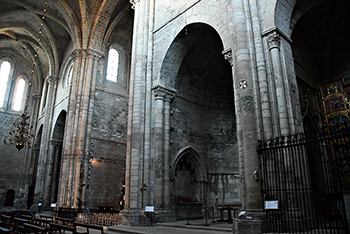The cathedral of Tudela: the medieval building
By Javier Martínez de Aguirre
|
|
|
|
|
|
|
|
|
|
|
|
|
|
|
|
|
|
|
|
|
|
|
Introduction
From its first decades of existence back in the 12th century, Santa María la Mayor, the most important church in the city of Tudela, was governed by a canonical community headed by a prior. In 1784 it was elevated to episcopal see, thus acquiring the cathedral dignity that it maintains today. The building stands out in the panorama of the non-episcopal Iberian canonicals of the Romanesque period both for the ambition of its architecture and for the rich figurative programs displayed in its doorways and cloister. Among its promoters, along with its own clergy, it had the favor of the lineages of the urban patricians and the support of the Navarrese monarchy, especially Sancho VII the Strong (1194-1234), of the sovereigns of the House of Champagne Theobald I (1234-1253) and Theobald II (1253-1270), and of Charles III the Noble (1387-1425). Fortunately, the medieval architects who worked on it knew how to harmoniously adapt each new project to the previously existing, in such a way that the late Romanesque forms connect without stridency with the fully Gothic solutions. Equally remarkable are the creators of the two main sculptural enterprises: on the one hand, the cloister, with its rich iconography and harmonious compositions; on the other, the Judgment Gate, where the fertile imagination of the sculptors gave shape to the full medieval convictions about life in the hereafter.
MARTÍNEZ ÁLAVA, C. J., Del románico al gótico en la arquitectura de Navarra. Monasteries, churches and palaces, Pamplona, Government of Navarra, 2007.
MELERO MONEO, M.ª L., La catedral de Tudela en la Edad average. Siglos XII al XV, Bellaterra, Universitat Autònoma de Barcelona, 2008.
MELERO MONEO, M.ª L., Escultura románica y del primer gótico en Navarra y Aragón: miscelánea de programs of study, Bellaterra, Universitat Autònoma de Barcelona, 2012.
VV.AA., La catedral de Tudela, Pamplona, Government of Navarra, 2006.









